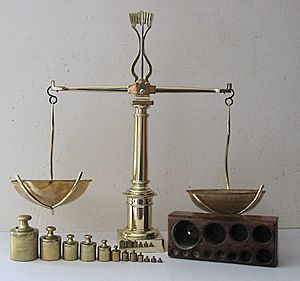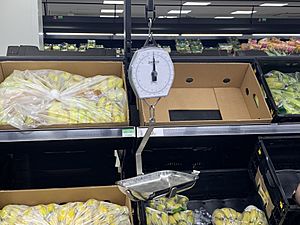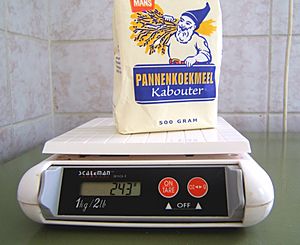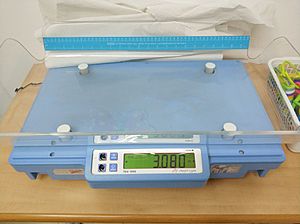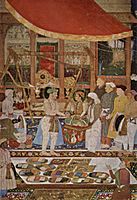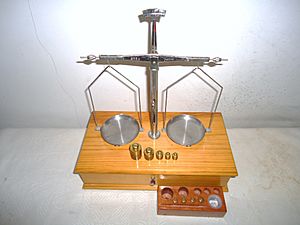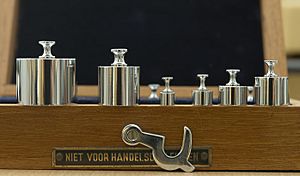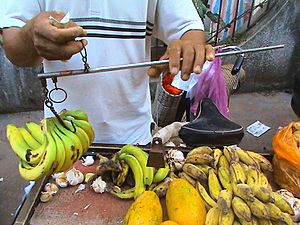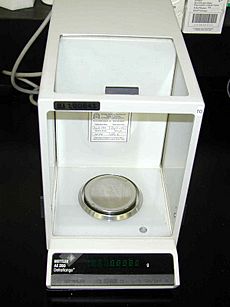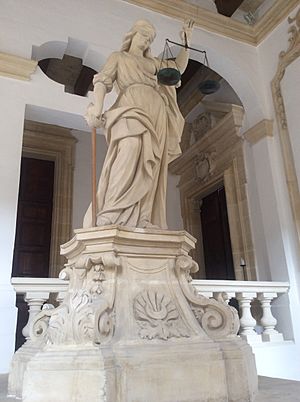Weighing scale facts for kids
A scale or balance is a tool used to measure how heavy something is, which is called its weight or mass. You might also hear them called mass scales, weight scales, or balance scales.
The most basic type, a traditional balance scale, has two flat plates or bowls hanging from a central bar. This bar balances on a point called a fulcrum. You put the item you want to weigh on one plate. Then, you add known weights to the other plate until both sides are perfectly level. When they are level, it means the mass on both plates is the same.
Another common type is a spring scale. This scale uses a spring that stretches or compresses when you put something on it. The heavier the object, the more the spring moves. This works based on Hooke's law, which describes how springs react to force.
Some scales can even measure force in units like newtons instead of mass in kilograms. Scales are super important in shops and businesses because many products are sold based on their weight.
Contents
How Balance Scales Work
The History of Scales

Balance scales are very simple tools, so people probably used them long before we found proof. Archaeologists found special stones that helped measure exact weights, which tells us scales were used for precise measurements.
The oldest signs of weighing scales come from the Indus River valley, dating back to around 2400–1800 BC. Before scales, it was hard to trade goods fairly. People found smooth stone cubes from ancient towns that were likely used as weights. Even though these stones had no marks, their weights were always multiples of a basic unit. This shows they were made specifically for weighing.
In Egypt, scales were used around 1878 BC, but they might have been around even earlier. Carved stones with weight marks and the Egyptian symbol for gold have been found. This suggests Egyptian traders used a system to measure gold. While no actual scales from that time survived, many weighing stones and pictures of scales show they were widely used. In China, the oldest balance found was from a tomb dating back to the 3rd or 4th century BC. It was made of wood with bronze weights.
Over time, different kinds of scales appeared. Even famous inventors like Leonardo da Vinci helped improve them. Until the 1600s, all scales were variations of the balance scale. Governments cared a lot about making sure people used the correct, standardized weights for fair trade.
-
Weighing dishes from the island of Thera, from the Minoan civilization (2000–1500 BC)
-
Assyrian lion weights from the 8th century BC, now in the British Museum
-
Emperor Jahangir (who ruled from 1605–1627) weighing his son Shah Jahan on a scale, painted in 1615.
The first balance scales had a beam with a pivot point in the middle. For very accurate measurements, this pivot was often a sharp V-shape resting in a shallow V-shaped groove. To find an object's mass, you would hang it on one end of the beam and hang known weights on the other end until the beam was level. For very precise work, like in chemistry, these center-beam balances are still among the most accurate tools.
Mechanical Scales
A mechanical balance (also called a balance scale or beam balance) was the first tool invented to measure mass. It has a horizontal bar (the beam) that pivots in the middle, with two pans hanging from its ends. You put the unknown item in one pan and add standard weights to the other until the beam is as level as possible. For super accurate balances, a small sliding weight can be moved along a marked scale to get a more exact measurement.
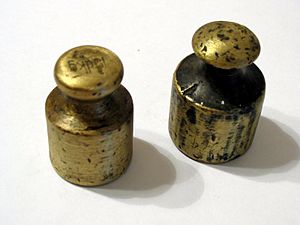
Unlike scales that use springs, mechanical balances are great for very precise mass measurements because their accuracy isn't affected by small changes in Earth's gravity. If you move a balance scale to a different place on Earth, the measurement of mass won't change. This is because the forces on both sides of the beam are affected equally by gravity.
To get very accurate results, the pivot point of the balance needs to have almost no friction. A sharp edge is often used for this. Also, a pointer attached to the beam helps show even tiny movements away from a perfect balance.
To make scales easier to use for large or awkward items, some designs use a platform that sits on a system of beams. This system transfers the weight to a smaller beam that is easier to read. You can still see this design in large portable scales used in places without electricity, or in older mechanical bathroom scales.
Roberval Balance
In 1669, a Frenchman named Gilles de Roberval invented a new type of balance scale. This scale had a unique design with vertical columns and equal-length arms that formed a parallelogram. What surprised people was that no matter where you placed two equal weights on the pans, the scale would still balance! This design was revolutionary because it made scales much easier to use.
Later, other types of balances were developed, including "gear balances" and "sprocket gear balances" that used interlocking gears or chains. While Roberval balances are generally less accurate than traditional beam balances because they have more moving parts (which means more friction), their ease of use makes them very popular for many everyday tasks.
Electronic Scales
Modern Electronic Devices
Electronic scales are very common today. They display the weight as a number, usually on a screen. They are very useful because they can do calculations and even send information to other devices.
Microbalances and Analytical Balances
A microbalance or nanobalance is a super sensitive tool that can measure extremely tiny masses, sometimes even less than a millionth of a gram!
An analytical balance is a type of scale designed to measure very small masses, usually in the sub-milligram range (less than a thousandth of a gram). The part where you place the item is usually inside a clear box with doors. This box, called a draft shield, stops dust and air currents from affecting the measurement. It's also important for the sample to be at room temperature, so air currents don't cause errors.
Electronic analytical scales don't use actual weights. Instead, they measure the force needed to balance the item. They use an electromagnet to create this force and then measure how much force was needed to get a balance. They need to be calibrated (adjusted) for different gravitational fields.
Programmable Scales
Some scales are "programmable," meaning they have a special computer chip inside that lets them be programmed for different jobs. This is useful for things like mixing ingredients in specific amounts, printing labels, or weighing large trucks.
Force-Measuring (Weight) Scales
History of Spring Scales
People talked about using spring scales to measure mass as early as the 1700s. The first design for a spring scale is credited to Richard Salter in 1770. Spring scales became very popular in the United Kingdom after 1840, especially for weighing letters and packages. Postal workers found them much faster than balance scales because they gave an instant reading without needing careful balancing.
By the 1940s, electronic parts were added to these designs to make them even more accurate. Devices called Load cells, which turn force into an electrical signal, started to become common later in the 20th century.
Mechanical Scales
A mechanical scale measures mass, force, tension, or resistance without needing electricity. Examples include spring scales, hanging scales, and triple beam balances.
Spring Scales
A spring scale measures mass by seeing how much a spring stretches or compresses under a load. This is different from a balance scale, which compares an unknown mass to known masses. Spring scales actually measure force, which is the pull of gravity on an object. They are usually adjusted so that the measured force shows up as mass (like grams or kilograms) at Earth's gravity. You can hang an object from the spring or place it on a platform that pushes down on the spring.
In a spring scale, the spring either stretches (like the scales in a grocery store produce section) or compresses (like a bathroom scale). Each spring has a special number (called a spring constant) that tells you how much it stretches or compresses for a certain amount of force. Scales use this constant and measure how much the spring moves to figure out the object's weight. Gears are often used to turn the spring's movement into a reading on a dial.
Spring scales have a couple of downsides compared to balance scales:
- The measured mass can change slightly depending on the strength of gravity in different places on Earth (up to 0.5%).
- The spring's stretchiness can change a little with temperature.
However, with good design and proper setup, spring scales can be accurate enough for use in shops. To fix the temperature problem, they might have special springs or need to be used at a steady temperature. To fix the gravity problem, they must be adjusted in the exact place they will be used.
Hydraulic or Pneumatic Scales
For very heavy items, like those weighed by crane scales, hydraulic (liquid-based) or pneumatic (air-based) systems are often used to sense the mass. The weight pushes on a piston or diaphragm, and this force is sent through tubes to a display that shows the weight.
Scales for Home and Shops
Electronic digital scales show weight as a number on a screen, usually an LCD. They are very useful because they can do calculations and connect to other digital devices. In a digital scale, the weight makes a spring or beam bend a little. This bending is measured by special sensors called strain gauges. A strain gauge is a wire whose electrical resistance changes when its length changes. For very large scales, a load cell (a type of hydraulic sensor) might be used instead. The scale sends electricity through the sensor, and the weight changes the electric current. This current is then turned into a digital number and shown on the screen. Most digital scales use a small computer chip to do all this.
Digital Bathroom Scales
A digital bathroom scale is a scale you stand on to measure your weight. The weight appears on an LED or LCD screen. Many modern bathroom scales can do more than just show weight; they can also estimate body fat, BMI, muscle mass, and water percentage. Some even connect wirelessly to smartphones or the internet to track your fitness over time. They usually run on small batteries. Weighing yourself often can be a helpful way to manage your weight.
Digital Kitchen Scales
Digital kitchen scales are used to weigh food when you are cooking or baking. They are usually small, light, and easy to store.
Strain Gauge Scales
In electronic spring scales, the bending of a beam that holds the weight is measured using a strain gauge. This is a wire whose electrical resistance changes when it stretches. The amount of weight these devices can measure is only limited by how strong the beam is. The readings from several sensors can be added together electronically, making this method perfect for weighing very heavy things like trucks and train cars, which is done on a modern weighbridge.
Supermarket and Retail Scales
You see these scales in bakeries, grocery stores, delis, and meat or produce departments. Supermarket scales can print labels and receipts, showing the weight, how many items, the price per unit, and the total price. Some even print special tags that can track the item. In most places, these scales are sealed and regularly checked to make sure they are accurate and cannot be tampered with.
Symbolism of Scales
Scales, especially the two-pan balance scale, are a classic symbol of justice. You often see them held by statues of Lady Justice. This idea comes from ancient Egypt.
Scales are also the symbol for the astrological sign Libra.
In a philosophy called Pyrrhonism, a perfectly balanced two-pan scale symbolizes the idea of having equally strong arguments for and against something, which leads to a state of suspended judgment.
Images for kids
See also
 In Spanish: Balanza para niños
In Spanish: Balanza para niños


